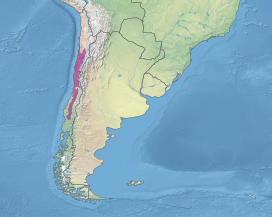Chilean Matorral
| Chilean Matorral (NT1201) | |
|---|---|
 Matorral scene in San José de Maipo | |
 Location in Chile | |
| Ecology | |
| Realm | Neotropical |
| Biome | Mediterranean forests, woodlands, and scrub |
| Borders | Atacama Desert, Central Andean dry puna, Southern Andean steppe, and Valdivian temperate forests |
| Geography | |
| Area | 148,500 km2 (57,300 sq mi) |
| Country | Chile |
| Climate type | BSk: arid, steppe, cold arid |
| Conservation | |
| Protected | 2,947 km² (2%)[1] |
The Chilean Matorral (NT1201) is a terrestrial ecoregion of central Chile, located on the west coast of South America. It is in the Mediterranean forests, woodlands, and scrub biome, part of the Neotropical realm.
Matorral is typically characterized by a temperate Mediterranean climate, with rainy winters and dry summers. It is one of the world's five Mediterranean climate regions, which are all located in the middle latitudes on the west coast of continents. The Mediterranean Basin, the California chaparral and woodlands ecoregion of California and Baja California, the Cape Province of South Africa, and Southwest Australia are the other Mediterranean-climate regions.
Setting[]
The Matorral occupies central Chile between 32° and 37° south latitude. The Pacific Ocean lies to the west, and the Chilean Coastal Range lies parallel to the coast. The Chilean Central Valley lies between the Coastal range and the Andes Mountains, which bound the Matorral ecoregion on the east. To the north is the extremely dry Atacama desert, which separates the Matorral from the tropical forests of northern South America. A semi-desert region known as El Norte Chico, (the "little north") lies between 28° and 32° south latitude, and is the transition zone between the Atacama desert and the Matorral. To the south lies the cooler and wetter Valdivian temperate rain forests ecoregion, which includes most of South America's temperate rain forests.
Flora[]
The Chilean Matorral ecoregion is home to several plant communities.[2]
- Coastal Matorral is a low, soft scrubland which extends from La Serena in the north to Valparaiso in the south. Typical species are the coastal daisy (Bahia ambrosioides), Palhuén (Adesmia microphylla), and Palo de Yagua, the wild coastal fuchsia (Fuchsia lycioides). The coastal matorral is similar to the garrigue of the Mediterranean Basin and the coastal sage scrub of southern California.
- Matorral is a shrubland plant community, composed of sclerophyll ("hard-leaved") shrubs and small trees, cactus, and bromeliads. Typical species include Litre (Lithraea venenosa), Quillay or Soapbark Tree (Quillaja saponaria), cactus (Echinopsis chiloensis), and bromeliads of genus Puya, with a diverse understory of herbs, vines, and geophytes. The matorral is similar to the chaparral of California[3] and the maquis of the Mediterranean Basin.
- Espinal is a savanna plant community, composed of widely spaced clumps of trees, predominantly Espino (Acacia caven) and spiny carob tree (Prosopis chilensis), with an understory of annual grasses introduced from the Mediterranean Basin in the 16th century. Much of the espinal was formerly matorral, degraded over the centuries by intensive grazing of sheep, goats, and cattle.
- Sclerophyll woodlands and forests were once more extensive, but now exist in small patches in the coast ranges and Andean foothills. The sclerophyll forests and woodlands are composed predominantly of evergreen sclerophyll trees, including Peumo (Cryptocarya alba), Boldo (Peumus boldus), Mayten (Maytenus boaria), and Chilean Wine Palm (Jubaea chilensis).
The ecoregion has many endemic plant species, with affinities to the South American tropics, the Antarctic flora, and the Andes. About 95% of the plant species are endemic to Chile, including Gomortega keule, Pitavia punctata, Nothofagus alessandrii, and the Chilean Wine Palm, Jubaea chilensis.
Conservation[]
The Matorral contains the majority of Chile's population and largest cities. The Central valley is Chile's main agricultural region, and the region is also subject to extensive grazing, logging, and urbanization. Of Chile's ecoregions, the Matorral is the least protected by national parks and preserves.
External links[]
- "Chilean Matorral". Terrestrial Ecoregions. World Wildlife Fund.
References[]
- ^ Eric Dinerstein, David Olson, et al. (2017). An Ecoregion-Based Approach to Protecting Half the Terrestrial Realm, BioScience, Volume 67, Issue 6, June 2017, Pages 534–545; Supplemental material 2 table S1b. [1]
- ^ Peter R. Dallman (1998). Plant Life in the World's Mediterranean Climates: California, Chile, South Africa, Australia, and the Mediterranean Basin. California Native Plant Society and University of California Press, Berkeley, California.
- ^ C. Michael Hogan (2008) Chilean Wine Palm: Jubaea chilensis, GlobalTwitcher.com, ed. N. Stromberg
- Chilean Matorral
- Ecoregions of Chile
- Flora of Chile
- Mediterranean forests, woodlands, and scrub
- Neotropical ecoregions